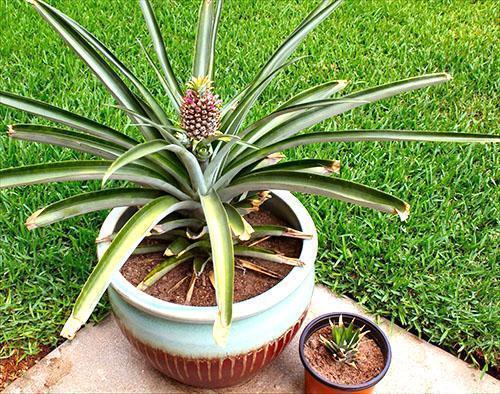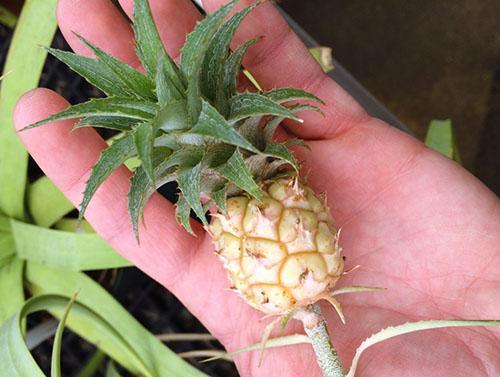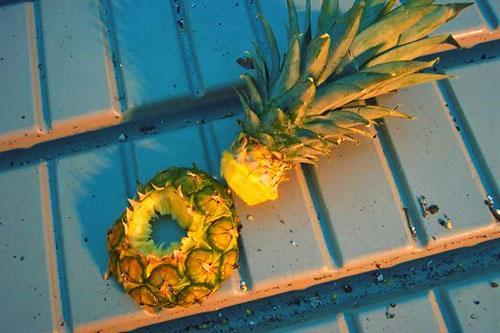Blooming and fruiting pineapples at home
 In nature, or rather not in plantations, where today you can find cultivars of pineapple, pineapple plants can grow up to one and a half meters. These are powerful herbaceous plants, gaining strength in 1–1.5 years, forming and giving the opportunity to ripen a large juicy fruit, beloved by many fruit.
In nature, or rather not in plantations, where today you can find cultivars of pineapple, pineapple plants can grow up to one and a half meters. These are powerful herbaceous plants, gaining strength in 1–1.5 years, forming and giving the opportunity to ripen a large juicy fruit, beloved by many fruit.
You can get your own pineapple at home:
- by purchasing one of the miniature ornamental plants in a specialized flower shop, often offered with a small fruit at the top of the shoot;
- self-planting the culture, using the apical outlet from the purchased ripe pineapple.
The first method must be recognized as more costly, but also the simplest, since the method of rooting and further growing pineapple from a green cut at home is a process involving a number of difficulties and rather lengthy.

Pineapple: indoor plant from the top of the fruit
If you decide to grow pineapple on your own, it is important to find the freshest fruit in the store with a green strong rosette, which does not have a broken growth point.
 A fruit worthy of procreation should not show signs of mold, rot, signs of frostbite and other influences that affect the viability of the plant. At home, from a pineapple, grabbing a couple of centimeters of the fruit, cut off the top. To prevent rotting of the cutting during rooting, the remnants of pulp and bark are cleaned from the leaf outlet, and dried lower leaves are removed. If the pineapple is ripe, the apical rosette can be unscrewed by firmly grasping the stem with one hand and the stalk with the other.
A fruit worthy of procreation should not show signs of mold, rot, signs of frostbite and other influences that affect the viability of the plant. At home, from a pineapple, grabbing a couple of centimeters of the fruit, cut off the top. To prevent rotting of the cutting during rooting, the remnants of pulp and bark are cleaned from the leaf outlet, and dried lower leaves are removed. If the pineapple is ripe, the apical rosette can be unscrewed by firmly grasping the stem with one hand and the stalk with the other.
 You can root pineapple at home, as in the photo, in a light loose substrate consisting of a mixture of them peat, perlite, sand and crushed charcoal, or in water. And in fact, and in another case, the stalk is preliminary:
You can root pineapple at home, as in the photo, in a light loose substrate consisting of a mixture of them peat, perlite, sand and crushed charcoal, or in water. And in fact, and in another case, the stalk is preliminary:
- dry;
- treated with a root stimulant;
- sprinkle with crushed charcoal.
To maintain humidity, the container with the apical rosette is covered with a bag or placed in a greenhouse, where the future plant will have to be until the first roots appear.
 The root system of a pineapple, be it a houseplant or a varietal fruit crop, is not very powerful. It develops quite close under the surface of the soil, so there is no need to wait for a tangled bunch of roots to appear in a container with water. To make acclimatization easier, it is better to plant a leaf rosette with roots up to 2-4 centimeters long in the ground.
The root system of a pineapple, be it a houseplant or a varietal fruit crop, is not very powerful. It develops quite close under the surface of the soil, so there is no need to wait for a tangled bunch of roots to appear in a container with water. To make acclimatization easier, it is better to plant a leaf rosette with roots up to 2-4 centimeters long in the ground.
A mixture of garden soil, peat, sand and perlite is suitable as a substrate for planting an indoor flower or pineapple from a green cutting.
The components are mixed in equal proportions, and up to 5% of the volume of crushed charcoal is added to the soil as a structuring and disinfecting substance.
Conditions for the growth of pineapple at home
 A pot for home-grown pineapple is taken wide, but not deep. At the bottom, a drainage layer must be provided, and the plant is buried only a few centimeters when planting. It is important that the pineapple remains immobile until complete rooting.Therefore, watering it requires extreme caution.
A pot for home-grown pineapple is taken wide, but not deep. At the bottom, a drainage layer must be provided, and the plant is buried only a few centimeters when planting. It is important that the pineapple remains immobile until complete rooting.Therefore, watering it requires extreme caution.
The final rooting of the indoor pineapple plant is indicated by the appearance of young bright green leaves from the center of the rosette. Old foliage begins to dry out and die off.
If within two months from the moment of planting there are no signs of renewal, this indicates rotting of the base of the cutting or damage to the growing point. Such a top will have to be removed, and rooting should be carried out with a new outlet.
To prevent the soil and old foliage from becoming a place of concentration of harmful microorganisms and pests, obsolete leaves are regularly removed.
Indoor pineapple has increased requirements for watering the plant. To moisten the soil, settled warm water is used, not colder than air. For a crop that loves to grow in acidic soil, a little citric acid can be added to the irrigation water. Watering is carried out once a week, making sure that the soil does not dry out between procedures, but does not accumulate excess moisture either.
 Pineapple can be watered so that water gets into the socket. The structure of the plant is such that moisture accumulating on the leaves necessarily rolls down to the base of the stem and gets to the roots. The main thing is that in this case the soil is not overly humidified, and the air does not cool below 23 ° C.
Pineapple can be watered so that water gets into the socket. The structure of the plant is such that moisture accumulating on the leaves necessarily rolls down to the base of the stem and gets to the roots. The main thing is that in this case the soil is not overly humidified, and the air does not cool below 23 ° C.
The optimum temperature for keeping a houseplant like pineapple is 23–30 ° C. Only for a period of rest, lasting from autumn to spring, is it permissible to drop the temperature to 18 ° C. A higher temperature background causes the plant to stop growing, and a flowering pineapple can throw off the collected inflorescence.
The best place in an apartment for a pineapple indoor plant is the southern, western or eastern windows, where the flower pot must be protected from direct sunlight, drafts and the drying effect of heating appliances.
 As it grows, as in the photo, the pineapple at home will have to find a spacious, lighted place. And if necessary, I equip the plant with illumination, which provides a day length of about 12-15 hours. With the onset of a dormant period and air cooling, watering is somewhat reduced, but the lighting should not decrease.
As it grows, as in the photo, the pineapple at home will have to find a spacious, lighted place. And if necessary, I equip the plant with illumination, which provides a day length of about 12-15 hours. With the onset of a dormant period and air cooling, watering is somewhat reduced, but the lighting should not decrease.
When growing pineapple as a houseplant, you need to know that the culture is a perennial, forming a leaf rosette in the first year, and ready to bloom in the second.
In summer, it is useful to put pineapple in the garden or on a warm, wind-protected balcony. And a year later, in the spring, the plant is transplanted into a pot with a larger diameter. Moreover, this is best done by simply transferring the earthen lump into a new container and adding a new soil mixture on the sides and on top.
 This technique will give the pineapple an incentive for further development. But this is not enough to make the pineapple feel completely comfortable. Therefore, the indoor culture from spring to autumn must be fed with liquid complex agents, and also in hot periods, crown irrigation is used.
This technique will give the pineapple an incentive for further development. But this is not enough to make the pineapple feel completely comfortable. Therefore, the indoor culture from spring to autumn must be fed with liquid complex agents, and also in hot periods, crown irrigation is used.
A video about pineapple at home will tell you in detail about creating conditions for the plant and about the necessary care.
Pests and diseases of the indoor pineapple plant
 In an apartment, pineapple lies in wait for the danger of insect pests and diseases, which often occur when plants are waterlogged or if the temperature is not observed.
In an apartment, pineapple lies in wait for the danger of insect pests and diseases, which often occur when plants are waterlogged or if the temperature is not observed.
And pests to pineapple, as to a room flower, are "not indifferent" to mealybugs and spider mites.
If the soil is not thoroughly sterilized before planting, the root system and stems of the plant may suffer from nematodes. Aphids and scale insects can be seen on domestic plants transferred to the garden for the summer. Insects can be dealt with by treating the green part with soapy water and by means of insecticides.
If the stem, roots or the central part of the outlet rots in a pineapple, then you cannot do without fungicides and removing the affected parts of the plant. A rotten growth point in a indoor pineapple plant is the reason for the suspension of development.But it's too early to get rid of the flower! Most often, the recovered specimen in the leaf axils and at the base of the rosette forms subsidiary lateral shoots.
How to make indoor pineapple bloom?
 Often, when growing pineapple at home, the plant is in no hurry to bloom. To provoke a culture to form inflorescences, you will have to use the technique used on plantations.
Often, when growing pineapple at home, the plant is in no hurry to bloom. To provoke a culture to form inflorescences, you will have to use the technique used on plantations.
Adult plants in early spring are treated several times with acetylene, obtained from calcium carbide and water, or with ordinary smoke, which in a month or one and a half should lead to the appearance of a rounded inflorescence above the rosette.
A spike consisting of densely planted flowers on a stem reaches 7-15 cm in length. The number of indoor pineapple flowers can be counted in dozens, and each of them has a greenish or purple perianth and a crimson or purple corolla. Corollas open gradually, starting at the base of the cone-like inflorescence. As a result, flowering lasts about a month, and then the growth of ovaries begins, quickly merging into a single, juicy seed.
Pineapple ripening can last up to six months. This period depends on the cultivated variety and type of plant.
 To facilitate the care of the plant, it is better to pick, as in the photo, pineapples at home, forming miniature decorative or edible sweet fruits.
To facilitate the care of the plant, it is better to pick, as in the photo, pineapples at home, forming miniature decorative or edible sweet fruits.
When a ripe fruit is cut, the plant loses its growth point, so it is better to renew it, as on industrial plantations, by replanting one of the rooted lateral processes that appeared on the mother plant during growth. This measure is necessary both for plants obtained from apical rosettes and for store-bought pineapple houseplants.